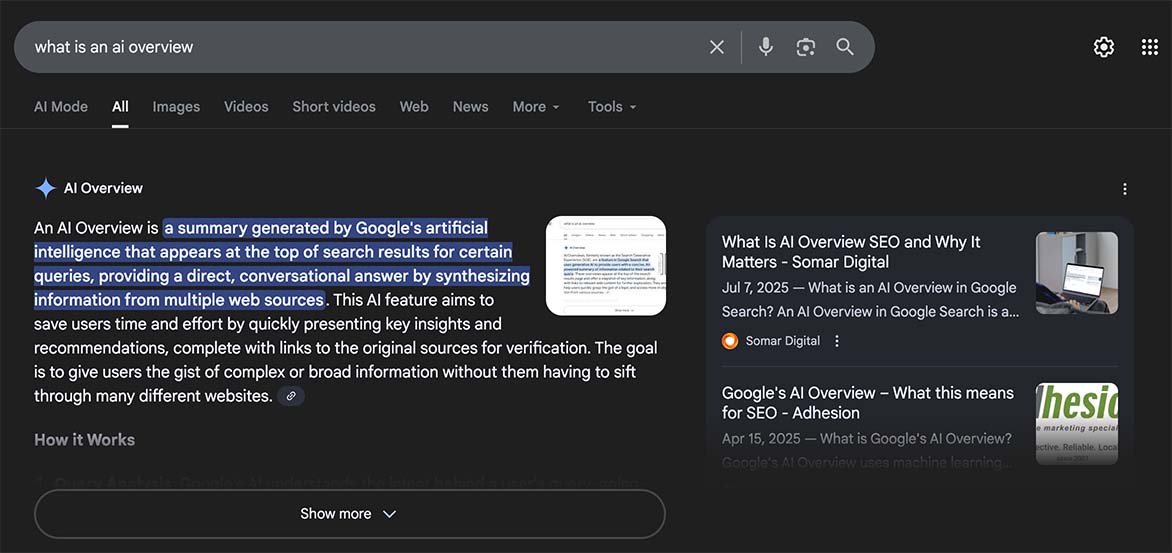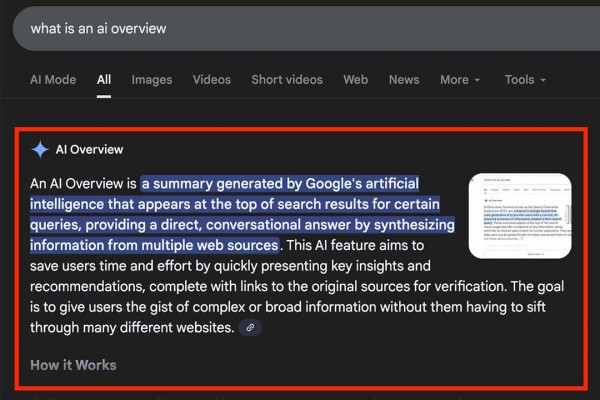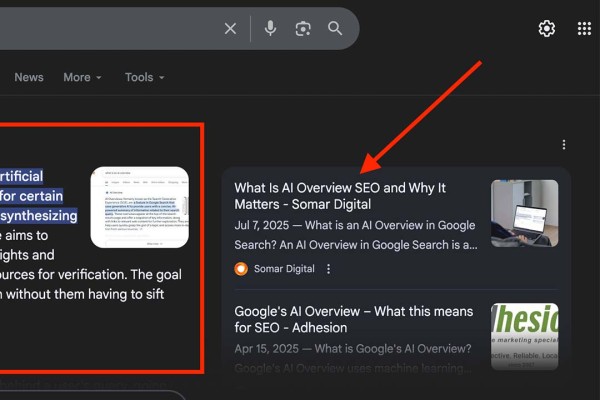If you’ve spent any time on Google over the last few months you may have noticed a section at the top of the search results called AI Overview. You might also be wondering how you get your site to rank in the overview.
These AI overviews are part of a growing trend where search engines like Google use generative AI to answer search queries with conversational responses, rather than just displaying a list of links.
Thankfully you don’t have to make any drastic changes to your SEO strategy but there are ways to increase the likelihood that your content appears in an AI overview. But first, what exactly is an AI overview?

What is an AI Overview?
An AI overview is a short, AI-generated summary that appears at the top of some Google Search results.
It provides users with an immediate, conversational answer to their query, often accompanied by links to the sources the AI pulled information from.

Unlike featured snippets, which extract a block of content from a single page, AI overviews synthesise content from multiple websites and reword it into a new paragraph.
They are currently part of Google's Search Generative Experience (SGE)(external link), which is rolling out gradually and expected to become a core part of how people search online.
If your content does make it into an AI overview, Google will also link to the relevant webpage to the right of the overview.

How Does Google Create AI Overviews?
To understand AI Overview SEO, we need to first look at how these summaries are generated.
Google uses its Gemini generative AI(external link) model to scan and summarise content from across the web.
This model:
- Indexes pages in Google Search, including metadata, structured data, and on-page content
- Understands search intent using natural language processing
- Pulls high-authority, relevant content from indexed pages
- Generates a conversational response that links to “web sources” it has used
Unlike traditional snippets, the AI may not pull direct quotes or exact text from a page.
Instead, it rewrites ideas and facts into its own words.
This means SEO strategies must now focus on providing clear, structured, and trustworthy content that AI models can easily interpret and summarise.
Is There a Difference Between Traditional SEO and SEO Optimised for AI Overviews?
Traditional SEO focuses on ranking well in the classic blue link results, using methods like keyword optimisation, backlinks, and strong technical performance. For the most part, traditional SEO best practices still apply but there are a few ways that optimising your SEO for AI overviews can differ.
AI Overviews, however, are part of a shift towards Generative Engine Optimisation (GEO)(external link). GEO is the practice of tailoring content for search engines that use generative AI to build their results, like Google’s AI Overviews. Optimising for GEO means creating structured, authoritative, and conversational content that AI can easily summarise.
In short, traditional SEO helps you rank within search results, while GEO ensures your content is chosen and presented within AI-driven search results.
What Makes Content Eligible for AI Overviews?
To improve your chances of being featured in AI summaries, there are a few key areas you can focus on:
- Authoritative: Demonstrate subject matter expertise and accuracy
- Clear: Use natural, easy-to-understand language
- Content Variety: Create different forms of content. Google pulls information from a wide range of places, including Youtube, and forum based sites like Reddit and Quora
- Structured: Incorporate proper HTML headings, FAQs, bullet points and schema markup
- Factual: Back up you content with trusted sources and clearly cite data
- Intent: Your content needs to address topics that your audience is actually searching for. Tools like Semrush and Google Search Console can help with keyword research
Google tends to favour content with good E-E-A-T signals(external link) (Experience, Expertise, Authoritativeness, and Trustworthiness). Ultimately, content written with a human tone but optimised for both search engines and readers is more likely to be picked up by AI.

How Can You Optimise for AI Overviews?
If you’re wondering how to adapt your SEO strategy to best position your content for AI overviews, here are some practical steps to follow:
1. Write with Clarity and Purpose
AI overviews prioritise content that answers questions directly and is easy to understand.
- Use short paragraphs.
- Answer questions directly and in plain English.
- Avoid fluff or jargon.
2. Use Conversational Subheadings
Framing subheadings as natural questions helps AI connect your content with real search intent.
- Include subheadings in the form of common questions.
- This helps AI systems match your content with natural search queries.
3. Add FAQ Sections
FAQs provide quick, structured answers that AI can easily extract and showcase in summaries.
- Include FAQ blocks at the bottom of your content with succinct, clear answers.
- This increases your chance of being pulled into an AI summary or featured snippet.
4. Use Lists and Tables
Structured formats make it easier for both AI and users to digest and share information.
- Bullet points and structured content are easier for AI to parse and repurpose.
- It also improves readability for users.
5. Improve E-E-A-T Signals
Demonstrating expertise and trust builds credibility with both search engines and readers.
- Include author bios.
- Link to reputable sources.
- Add case studies or testimonials to build trust.
6. Add Relevant Structured Data
You may already have Schema markup(external link) added to your webpages but it is also worth adding a llms.text file to your website.
An llms.text file(external link) helps AI and Large Language Models (LLMs) understand your website content better.
Are There Any Downsides to AI Overview for SEO?
While AI overviews can increase visibility, SEO-experts have noticed a few changes in the way their content is performing:
- Reduced Click-Through Rates: If users get the answer in the AI summary, they may not click through to your site
- Content Misinterpretation: The AI might summarise your content inaccurately, leading to confusion or misattribution
- Ranking Volatility: You may rank well one week and disappear the next, depending on changes in AI training data
The key thing to remember if you notice any of this happening to your content – don’t panic!
Remember, good SEO is about being consistent. Not just in how often you publish but also in keeping your messaging aligned across every channel, from social media and press releases to your website. If your content is technically sound and written with your audience in mind, you’ll be in a strong position to adapt over time and increase your chances of appearing in AI Overviews.
Is AI Overview SEO Here to Stay?
The short answer is yes.
All signs point to AI becoming more integrated into the way people search online.
Google, Microsoft (via Bing), and other platforms are heavily investing in generative AI search.
For New Zealand businesses, adapting to this shift now can help maintain visibility and authority in your niche.
Looking for a partner to guide you through the shift to AI Overview SEO? Somar Digital can help you set your site up for success with tailored SEO support.




